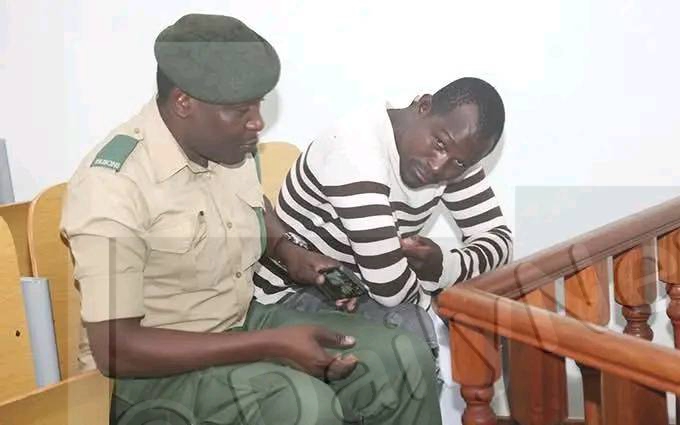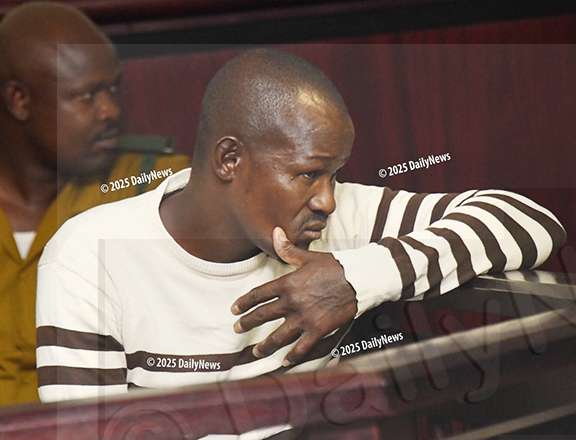Sedudu shooting Inquest - Day 6
23 Nov 2021
Inquest day 6 Keamogetse Letsholo reports on proceeding sof the morning session of day six of the enquiry Witness number 25 – Inspector Michael Josiah A crime scene investigator, Insp. Josiah told the enquiry that on November 6, at around 0700hrs, he left the office in the company of Superintendents Mothatego and Fane (who has since passed on) and who was the investigating officer. “Upon arrival, Lieutenant Mphela introduced me to the scene. From where I was standing, there were two canoes in the Chobe River in the channel east of Sedudu Island. In one of those canoes, I could see two male human bodies and in the other canoe, there was one male body, while the fourth body was lying on the edge of the water channel not far from the two boats,” he said.
He told the court that the body that rested on the edge was identified as that of Martin Nchindo, while the lone dreadlocked one in the first canoe, was of Tommy Sinvula Nchindo. The other two bodies in the second boat were those of Ernest Nchindo and Sinvula Munyeme “In the canoe with two bodies there was a 12.5kg A1 Super Maize Meal bag with three tusks, suspected to be those of elephant,” he said. He also found a pair of sharp-nose pliers, four wooden paddles and two spears in the canoes. “I paced to measure the spears and the paddles. The spears were about my three normal walking paces, and the paddles were 4.5 times my normal walking paces,” he said.
Inspector Josiah is roughly 1.75 metres tall. He also took pictures of the bodies, whilst one Insp. Morapedi searched them. The search of the body that was later identified as that of Sinvula Munyeme, yielded a black Viny phone, 2x100 Zambian Kwacha notes, 2x100 Namibian dollar notes, a 50 Namibian Dollar note and a 10 Namibian Dollar note.
Subsequent to the search the late Supt Fane supervised transfer of the bodies to Kasane Primary Hospital where the four were certified dead, he said. Insp. Josiah explained that on November 12 he, together with Supt. Fane took the bodies to Francistown for postmortem. The bodies were subjected to x-ray at Tati River Clinic from where they transferred them to Nyangabgwe Referral Hospital mortuary.
The following morning one Charles Nchindo identified the bodies as those of his family members, before the autopsy, which was performedby one Dr Mabaka. “In the postmortem room I was taking pictures and Dr Mabaka gave me instructions on what to take as pathologists always do. Other people who were in the room were Supt. Fane, Deputy Commissioner Simasiku from Namibia, Warrant Officer Mahwila of Namibia, Dr Amis from Namibia and Assistant Commissioner Eanya of Botswana Police,” he told the court.
“When the pathologist searched the bodies, he found a brown wallet in Tommy Sinvula Nchindo’s inner shorts. In the wallet was Namibian ID bearing Tommy’s names, Namibian voters card in the same names, three passport size photos; two resembling the same facial features as the deceased and the other one was that of a lady, 2x200 Namibian dollar notes and 2x100 Namibian dollar notes”, said Insp. Josiah. Following the postmortem, the bodies were on November 14, taken to Ngoma border post to be handed over to relatives in the presence of Deputy Commissioner Simasiku.
Insp. Josiah, told the court that the canoes, which were kept at Kasane police station as exhibits, were partly damaged by termites while in storage. “One grey sweater that was found at the scene was sent to police forensic laboratory, and I am reliably informed it was sent to South Africa for further investigations. The sweater had fur that is suspected to be that of an animal,” he said. BDF director, military prosecutions, Major Abel Motaung was the first from the public to throw an ostensibly helpful question.
“While you were taking pictures of the bodies at the scene, did you notice any swelling of the faces?” asked. “No your honour I did not notice any swelling,” answered Insp. Josiah. “Charles Nchindo told this court that the faces of the deceased were swollen, what is your take?” asked Major Motaung. “During postmortem, the faces had changed from how I saw them at the scene, maybe due to decomposition,” he responded.
“During your search of the canoes, did you find any gun/guns that you were told shot the soldiers?” Major Motaung asked. “No guns were found, but on the 19th, a search, which was later called off, was conducted in the water by the BDF and NAMPOL scuba divers,” he said. “As you earlier told the court that when the anonymous call was made you were on duty at the radio control room, did the caller mention the make of the guns that he said the alleged poachers were armed with?” asked the Namibian State Prosecutor, Mr Bornfree Konga.
The answer was in the negative. Mr Konga then asked how he ensured the integrity of the evidence collected at to which Insp. Josiah responded by saying he secured all evidence through pictures taken using a camera. “Do you agree that it is imperative to preserve the evidence collected at the crime scene?” asked the Namibian prosecutor. “I preserved the evidence, that is why it is before court today,” responded Insp Josiah. “What about the canoes? Were they properly preserved?” asked Mr Konga.
“They were only handed to me after the passing on of the substantive investigating officer,” responded Insp. Josiah. Mr Konga pressed, “Were the alleged elephant tusks sent for analysis and what was the outcome?” “Yes they were but I don’t have the outcome. I think the outcome will be presented to the court by the officer, who was investigating the case of unlawful possession of elephant tusks,” answered Insp Josiah.
The Namibian governor of the Zambezi Region asked next and he wanted to know if fingerprints were lifted off the tusks. Insp. Josiah explained that the tusks were submerged in water in the canoes and the water would have erased any. “One can argue that the tusks were planted by someone else, what would you say?” “I doubt because I was told that the scene was protected by the BDF overnight,” he responded. Mr Sampofu went on to suggest that the A1 bag did not resemble any of the maize meal brands eaten in Namibia.
“People from Namibia always buy food here in Botswana at Spar and Choppies. We always them,” countered Insp. Josiah. At this point the governor rested his case. Major Joshua Gabothuse of the BDF Military prosecutions asked after the governor and he wanted to know if Inspector Josiah had seen anything in the faces of the deceased that suggested they had been assaulted. Inspector Josiah said he did not see anything of the sort. He then asked if Charles Nchindo and Cassius Mwala had seen the deceased at the scene.
Once again his answer was negative. “Charles and Cassius indicated to this court that the deceased’s faces were swollen and one had a cut, and they concluded that they were assaulted, what is your view?” Inspector Josiah said the statements by the two men were not correct. Another member of the public, a relative of the deceased, one George Nchindo then asked Insp. Josiah if he ever followed up to find out what network the “anonymous” caller was using.
When Insp. Josiah explained that that was the duty of the Investigating Officer, Nchindo retorted, “We want to know who that caller is whether he is indeed a Namibian as you said he spoke broken Tswana,” stated Mr Nchindo. “ A Zimbabwean or Zambian can also speak broken Setswana,” came the rejoinder from Insp. Josiah. Mooketsi Mojalemotho reports on proceedings of the afternoon session of Day 6. Witness number 26 – Kaelo Nkile Mr Nkile, 41, holds a Bachelor of Science (BSc) degree in Biology from the University of Botswana and is currently working as a Biologist for the Department of Wildlife and National Parks. His scope of work includes among others; research on wildlife, its ecology to the ecosystem, identification of the originality of exhibits from animals and their analysis.
He identified the three tusks found in a Super A1 maize meal bag as elephant ivory. “After I have completed my work I put up an affidavit to say what I’ve found out,” he put it to the Deputy Director of Public Prosecutions, Kabo Leinaeng, who had wanted to know the steps he took upon concluding his findings. He however relayed that the three horns were not cut at the apex in their original form or at the material time he received them from one Detective Morapedi of Fauna and Narcotics Squad. Nkile had received full tusks, but had cut them for examination. “They were full horns.
I had to cut them for purposes of analysis. I then inscribed my initials K.E.N and the date on the surfaces of their tips,” he said, adding only then did he use morphometric technique to determine their identity. The Morphometrics is the quantitative analysis of form, which is a concept that encompasses both the size and shape of an organ or organism.
Using the methodology, he was able to confirm that the three objects were tusks of the African elephants. He also informed the enquiry that the three exhibits, identified as 23 A, 23 B and 23 C respectively, were as per procedure taken to Botswana Bureau of Standards for weight measure. Together the three tusks weighed 12 173.5 grammes, (or 12.1735 kg), and had a market value as certified by the Convention on International Trade in Endangered Species of Wild Fauna and Flora (CITES) of approximately P20 757.81.
Mr Nkile’s testimony somehow seemed to glue the mouths of any interrogator, save for Deputy DPP Director Mr Leinaeng’s guiding but unremarkable questions. Even the usually animated Namibian Lives Matter National Chairperson, Sinvula Mudabeti remained strangely quiet and would not take up the challenge by Principal Magistrate Taboka Mopipi’s for attendants to cross-examine the biologist.
Witness number 27 – Jan Gouwe Me Gouwe, 56, explained that he previously worked for Botswana Police Service forensic science laboratory beginning 1989, but had since the year 2000, been deployed to the Service’s ballistics unit.
A question was asked by one of the Namibians in the gallery as to whether as a ballistic expert he was able to link the greyish metal fragments found at the scene of the incident to the fire-arm or fire-arms that were used during the night of November 05, 2020, to which he answered in the negative. “My scope of laboratory tests only went as far as determining if the metal fragments were from a projectile or bullet and not to link them to any fire-arm.
No firearm was given to me and my team of experts to test,” he explained. However when he finished examining the items, he concluded that they were components of ammunition, he said. However, a substantial number of Namibians in the gallery displayed skepticism about the explanation given by the ballistic expert. Witness number 28 This would be either one of two officials from Namibia, but who somehow disappeared into thin air when they were sought. This rubbed Regional Magistrate Mopipi the wrong way. “It is the court that controls time.
I want one more witness. Avail one Mma Dibeela and advise your witnesses to always hang around until such time as determined by the court,” she said firmly Efforts by a number of judicial officers to locate the two Namibians proved to be in vain. Assistant Director of Public Prosecutions, Ms Thato Dibeela later told court their phones were ringing unanswered.
“Three other witnesses have just arrived and could not be brought here to testify due to COVID-19 protocols. Until their results are out their movement remains restricted,” Ms Dibeela explained beforean evidently frustrated Magistrate Mopipi called for adjournment of proceedings. The enquiry is expected to continue until Friday at the old Chobe Council chambers. ENDS
Source : BOPA
Author : Keamogetse Letsholo and Mooketsi Mojalemotho
Location : KASANE
Event : Inquest
Date : 23 Nov 2021







